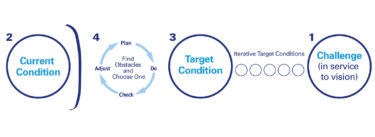“Seeing the work” is an essential yet often misunderstood lean management concept, though, at first glance, it seems to be one of the most straightforward. What could be easier than taking a close look at your work process with an aim toward improving it?
Yet lean practitioners who’ve learned how to it will tell you that this simple concept isn’t as easy to learn as you might think. Indeed, they’re likely to admit that, much like most lean practices, they only truly understood what’s involved in seeing the work when they were guided through the process by a lean sensei or coach.
In this brief video, Instructional Designer Masia Goodman offers a glimpse into how seeing the work through the lean perspective of only one of the seven wastes typically found in production helped her reduce cycle time, errors, and the physical demands of the work.
She also reveals two additional lean tips that increase the success of the improvements identified by seeing the work.
Finally, Goodman notes that operators feel respected when enabled and empowered to improve their work processes, which explains why lean leaders make the practice integral to everyone’s job.
Learn to ‘See the Work’
Get the coaching you need to learn and fully appreciate what it means — and what it takes — to make seeing the work a core element in your lean practice by participating in an upcoming Building a Lean Operating and Management System workshop. The hands-on, simulation-based learning lets you experience a lean management operating system based on seeing the work, giving you the insights and information you need to create a management system that cultivates a culture built on respect for people, continuous improvement, and problem-solving.
Editor’s Note: This Lean Post is an edited version of an article published in February 2020 that is one of the most popular posts about this vital lean practice.
Building a Lean Operating and Management System
Gain the in-depth understanding of lean principles, thinking, and practices.





